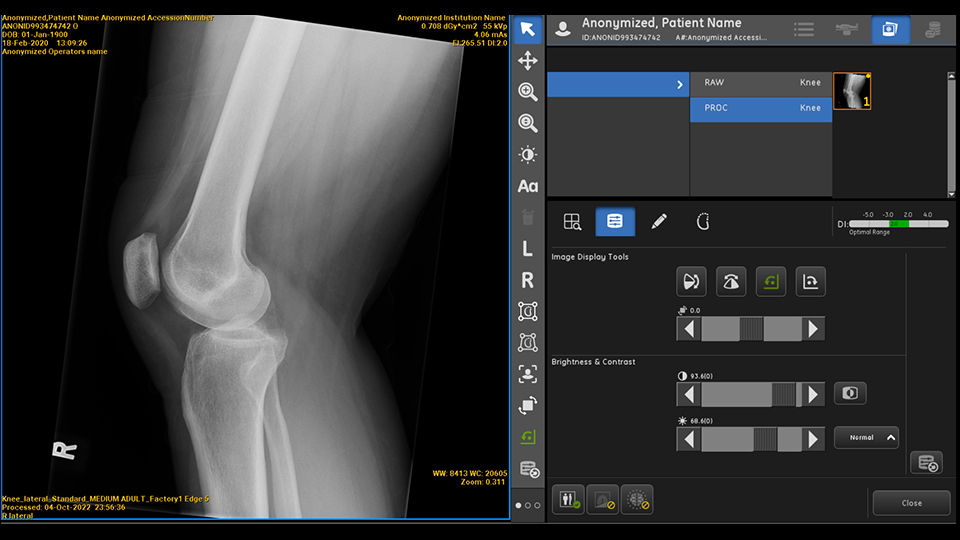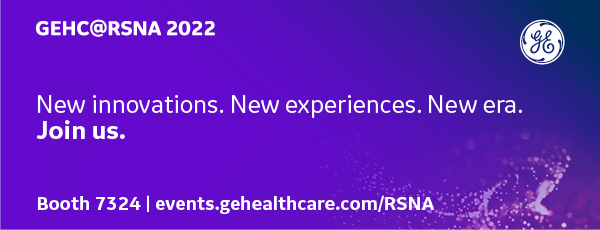More than 80 percent of all health system visits include one imaging exam, making radiology an essential part of diagnostics and healthcare. X-ray is the most prevalent imaging exam in radiology departments, accounting for 60 percent of all imaging studies.[1]
Paired with ultrasound, X-ray accounts for most of the estimated 4.2 billion imaging procedures performed in 2019.[2] Because of its key role in patient care, the quality of imaging services and workflow efficiencies in radiology remains a focus for hospitals and health systems as they balance increasing demands for imaging services and a simultaneous shortage of radiologic technologists.[3] Getting the right image the first time is crucial, but with limited and often inexperienced staff, a hospital’s ability to consistently provide high-quality imaging can be challenging and can result in problematic X-rays.
Recent studies show that out of 500 portable chest X-rays evaluated, 231, or 46.2 percent were problematic. Forty-three percent of the problematic X-rays requiring a repeat portable chest X-ray showed that there was a technical problem impacting the ability to detect pathology. In addition, it was found that the most problematic films occurred during the night shift. Technical issues that led to poor image quality included improper patient positioning, foreign objects covering anatomy, and variation in technologist ability or training.[4]
Healthcare administrators have identified improving efficiencies as a top area of focus in their facilities.[5] These administrators are beginning to utilize highly versatile devices such as X-ray systems embedded with artificial intelligence (AI)-based tools that can maximize workflow efficiencies for staff and, at the same time, help radiology departments maintain quality imaging services.
Integrating AI solutions into innovative X-ray systems
The development of more clinically focused AI solutions is on the rise, and radiology is one area where AI has proven very effective. X-ray systems are helping clinicians provide diagnostic care with a suite of on-device AI algorithms to detect potentially life-threatening conditions and to help prioritize the most critical cases for reading physicians. However, AI applications in X-ray can also serve to facilitate the X-ray workflow, such as guiding image acquisitions for technologists and improving imaging consistency and quality at the point of care.
Leaders in the industry, such as GE Healthcare, are developing innovative imaging AI tools that bring more efficiency to diagnostic accuracy and the clinical workflow in radiology.
“We’re designing our X-ray systems with embedded AI solutions that not only enable clinicians to make more confident diagnoses,” says Brien Ott, Director of Global Marketing for Mobile X-ray at GE Healthcare, “but also ease the workflow burden of imaging technologists with real-time quality alerts and automation of repetitive tasks. We’re focused on developing solutions that encompass the latest imaging technologies and AI that can help our customers address current staffing challenges while continuing to provide high-quality imaging services for patients.”
Maintaining consistent image quality with embedded AI applications
Across the X-ray industry, up to 25 percent of exams can be rejected or repeated, with 68 percent of repeat exams due to poor positioning.[6] With real-time feedback on whether the technologist is using the correct protocol and whether they have the correct anatomy in the field of view, the need for repeat exams can potentially be reduced.
AI innovations in X-ray are helping to improve triage and diagnostics as well as quality and workflow efficiencies. GE Healthcare’s collection of on-device AI algorithms for X-ray helps clinicians with automated chest X-ray measurements and case prioritization, and it helps technologists improve image consistency with real-time quality controls. It features tools intended to assist technologists in correcting anatomical positioning and confirming protocol selections at the time of each scan, as well as auto-rotating images to save time for reading radiologists.
Because radiographic technologists have varying experience levels, they are likely to perform the same exam differently. This variability can lead to inconsistent image quality and operational inefficiencies that necessitate repeat exams and impact a facility’s scheduling capacity and radiologist throughput. Using on-device AI tools to help technologists correct acquisition errors during the exam can maximize operational efficiency, eliminating rework, variability reporting and operational analysis to determine the cause.
Supporting X-ray technologists with streamlined workflows
Healthcare experts believe that the deployment of AI-based workflow solutions in radiology will continue to increase, vastly improving workflow efficiency, increasing clinical confidence, and reducing radiologist burnout.[7]
Innovations in X-ray are currently helping to automate many manual tasks for the radiographic technologist and save time on each patient. On-device, smart protocol tools can automatically alert the technologist if there is a protocol mismatch in the protocol assigned. In addition, the radiographic technologist can be alerted to other quality errors, such as an incomplete chest X-ray field of view or incorrect image orientation across multiple anatomies.
Rotating the image automatically, for example, is a smart solution that saves time for the radiographic technologist as they prepare images for the radiologist. Leveraging these time-saving features and allowing technologists to complete tasks with fewer clicks and correct errors during the exam period supports an environment of improved productivity, reduced stress, and increased patient throughput.
Expanding the future of AI in X-ray
Innovative solutions such as AI-based quality care solutions in X-ray have the power to both improve the quality of diagnostic imaging and efficiencies in radiology operations. The widespread utilization of advanced imaging technologies and AI tools supports providers’ efforts to deliver quality imaging services while addressing current staffing challenges more strategically.
Expanding AI capabilities and applications in X-ray to cover more anatomies has the potential to impact diagnostic accuracy and improve triage for critical cases thereby impacting patient outcomes across clinical specialties.
DISCLAIMER
Not all products or features are available in all geographies. Check with your local GE Healthcare representative for availability in your country.
REFERENCES
[1] IMV 2019 X-ray CR / DR Market Outlook Report) page 9, 37
[2] The IMV 2019 Global Imaging Market Outlook Report
[3] https://www.usnews.com/news/health-news/articles/2022-07-28/staff-shortages-choking-u-s-health-care-system
[4] Jin M X, Gilotra K, Young A, et al. (September 15, 2022) Call to Action: Creating Resources for Radiology Technologists to Capture Higher Quality Portable Chest X-rays. Cureus 14(9): e29197. doi:10.7759/cureus.29197
[5] The IMV 2019 Global Imaging Market Outlook Report
[6] Little, Kevin J., et al. "Unified database for rejected image analysis across multiple vendors in radiography." Journal of the American College of Radiology 14.2 (2017): 208-216.
[7] Global Medical Imaging and Informatics Outlook 2022, Frost and Sullivan.


